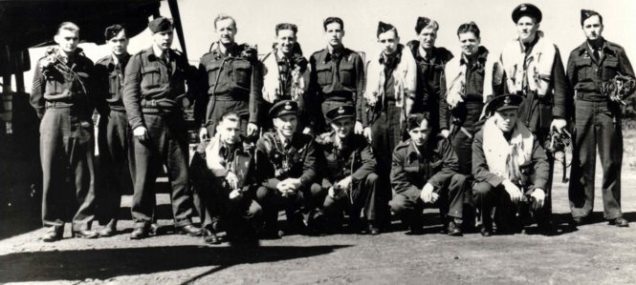The fifteen RCAF Aircrew who returned from the Dams Raid. Back Row: Oancia, Sutherland, O’Brien, Brown, Weeks, Thrasher, Deering, Radcliffe, MacLean, McCarthy, McDonald
Front Row: Pigeon, Taerum, Walker, Gowrie, Rodger. [Pic: Bomber Command Museum of Canada]
Plt Off G A Deering
Front gunner
Lancaster serial number: ED932/G
Call sign: AJ-G
First wave: First aircraft to attack Möhne Dam. Mine exploded short of the dam.
Although of Irish descent, George Andrew Deering was actually born in Kirkintilloch, Scotland, on 23 July 1919. He was the only boy in the family of the four children of Samuel and Martha Deering. The family emigrated to Canada when he was a small boy, and his mother died shortly afterwards. His oldest sister Charlotte then became the family housekeeper.
Deering went to Essex public school in Toronto, and then trained on a correspondence course in aircraft designing and mechanics while in employment as a shoe worker. He joined the RCAF in July 1940, hoping to become a pilot. However he ended up qualifying as a wireless operator/air gunner and arrived in England in April 1941.
Deering spent about a year in 103 Squadron at RAF Elsham Wolds and completed a full tour of operations. He was then sent to an Operational Training Unit, and was commissioned in February 1943, although this information didn’t seem to reach 617 Squadron until after the Dams Raid.
How Deering arrived on 617 Squadron and was then allocated to Gibson’s crew is a bit of a mystery. In Enemy Coast Ahead, Gibson wrote that he was a novice but this is far from the truth: ‘In the front turret was Jim [sic] Deering from Toronto, Canada, and he was on his first [sic] bombing raid. He was pretty green, but one of our crack gunners had suddenly gone ill and there was nobody else for me to take.’
Later in the book, Gibson calls him ‘Joe’ and in the dedication he is referred to as ‘Tony’. Giving a member of your own crew three different first names may well be a record, even for this book which is littered with editorial errors. Also, Deering was in fact posted into 617 Squadron on 29 March, and had flown on a number of training flights with Gibson in the run up to the Dams Raid.
For his part in the raid, Deering was awarded a DFC, recognition at last that he was an officer by the time of the raid. Along with Taerum, Hutchison and Spafford he transferred to George Holden’s crew, and died with all of them when they were shot down on the Dortmund Ems canal operation on 16 September 1943. He is buried in Reichswald Forest War Cemetery.
More about Deering online:
Air Force Association of Canada listing
Commonwealth War Graves Commission listing
Decoration awarded for Operation Chastise: DFC
KIA 16 September 1943
Rank and decorations as of 16 May 1943.
Sources:
Richard Morris, Guy Gibson, Penguin 1995
John Sweetman, The Dambusters Raid, Cassell 2002
The information above has been taken from the books and online sources listed and other online material. Apologies for any errors or omissions. Please add any corrections or links to further information in the comments section below.
 Further information about George Deering and the other 132 men who flew on the Dams Raid can be found in my book The Complete Dambusters, published by History Press in 2018.
Further information about George Deering and the other 132 men who flew on the Dams Raid can be found in my book The Complete Dambusters, published by History Press in 2018.

During the 30s George Deering was in my dad’s Scout Troop. Dad, Wilf Hilton, was so proud to have had a Dam Buster in the 42nd Toronto. We had a picture, long since lost, of his whole gang, most of whom served in WW II.
When actor Richard Todd came to Toronto to promote the film, he met with George’s father. There was a photo of them in the Toronto Star.
Hi my mum was a cousin of George, she was born the year he died, my grandmother was one of Samuels’ sisters
103 Squadron did not begin operating Halifaxes until after Deering had left the squadron, and his tour was undertaken on Wellingtons.